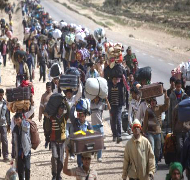Displacement Dilemma: Challenges Faced by Refugees in Camps and Cities
As of May 2023, an astonishing 110 million people worldwide found themselves forcibly displaced. Within this staggering number, nearly half were internally displaced, while 20 percent were refugees living in camps. These concerning figures come from estimates by the International Institute for Environment and Development (IIED), an independent research organization.
Perilous Prolonged Camp Stays
The IIED’s report reveals a concerning trend – camps established as temporary solutions during crises often evolve into long-term homes for displaced individuals when conflicts persist. Unfortunately, these extended stays in camps are marked by a lack of long-term strategic planning and inadequate facilities.
Remote and Restricted
Temporary living arrangements in camps are typically situated in remote areas, subjecting refugees to restrictions on movement and employment opportunities. This grim reality underscores the need for reevaluating the effectiveness of these camps.
Comparing Camps and Cities
In a pioneering effort, researchers conducted a large-scale assessment comparing the well-being and livelihoods of refugees and internally displaced individuals in camps and urban areas. The project, known as “Protracted Displacement in an Urban World,” focused on one camp and one city in each of the following countries: Ethiopia, Kenya, Jordan, and Afghanistan.
Debunking Myths
The study centered around four “myths” that emerged during the project. These myths pertained to assumptions about displaced individuals in cities being self-reliant, better-educated, camps serving as effective safe havens, and the potential for camps to evolve into self-sustained settlements.
Urban Refugees and Humanitarian Assistance
In Nairobi and Addis Ababa, the majority of refugee households, 76 percent and 88 percent respectively, receive no humanitarian assistance. Conversely, in Amman, 73 percent of refugees reported receiving aid. Notably, among those receiving aid, 20 percent relied on humanitarian assistance as their primary source of income.
Income Disparities
While more refugees and internally displaced people earned income through work in urban settings compared to camps across all countries in the study, the percentages varied. In Kenya and Ethiopia, urban displaced individuals fared better than their camp counterparts. However, significant proportions of the urban refugee population struggled to cover expenses, with figures reaching 33 percent in Kenya and 61 percent in Ethiopia. In Jordan, both urban and encamped refugees faced financial challenges.
Healthcare Disparities
Overall, 83 percent of respondents in cities and 69 percent in camps reported positive access to healthcare. However, women were more likely to face challenges in accessing healthcare. The study also revealed concerning reports of poor services and care for women during and after childbirth in camps.
A Call for Support
To address these challenges, humanitarian and development programs must collaborate with local and national governments. Providing incentives for authorities to remove barriers that hinder displaced individuals from leading decent lives in urban areas is crucial. This support is essential to enhance the well-being and livelihoods of displaced populations in both camps and cities.
Month: Current Affairs - September, 2023
Category: Reports & Indexes Current Affairs







